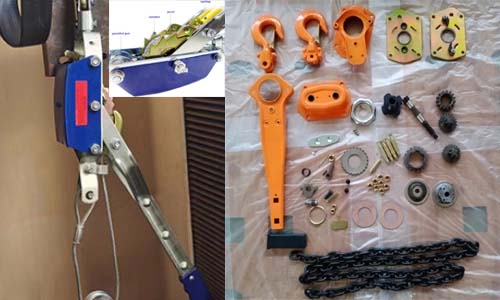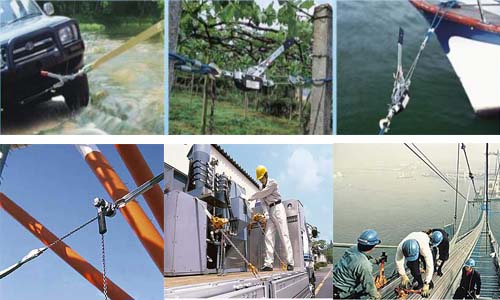Sometimes lever hoist is referred to as chain come along. Lever hoists and come alongs are both manual tools operated by a lever to achieve traction. However, they have many differences. Below, we will distinguish between lever hoists and come alongs from several aspects, making it easier for you to choose the correct traction tool.
Structural Difference
Lever hoists have a more complex structure compared to come alongs, so they are also much more expensive.
A lever hoist consists of upper and lower hooks, the lifting chain, a handle, gears, ratchets, brake discs, the driving shaft, and a load sheave, among other components. The hoist body is the core of the lever hoist. The transmission device of the lever hoist consists of long shaft gears, which convert human power into mechanical energy, driving the load sheave to rotate and thus lifting the load.
Come along, also called wire rope tighteners, or double-hook tighteners, have a simple structure consisting of two lifting hooks, a handle, wire rope, parallel jaws, pawls, ratchets, springs, and others.

Differences in Usage
Lever hoists have three directions: up, down, and neutral. In the neutral position, the lifting chain can be pulled freely. The handwheel of the lever hoist can also be used to adjust the load chain a little. First, secure the upper hook, hang the lower hook on the object that needs to be pulled or lifted, set the block to “up,” adjust the chain by fine-tuning the handwheel, and then lift or tighten the load by operating the handle up or down. When the block is set to “down,” it indicates lowering or loosening the load.
Using a come along is straightforward; you only need to operate the handle to tighten. When it is necessary to loosen the wire rope, first move the spring forward, lifting the pawls, then push the parallel jaws forward forcefully. This action causes the parallel jaws to disengage from the ratchet, loosening the wire rope. Releasing the load on a double-hook tightener is more dangerous, so careful operation is required. Push the handle towards the parallel jaws, allowing the ratchet to retreat tooth by tooth until there is no load.
Differences in Specifications
Lever hoists come in various specifications such as 0.25T, 0.75T, 1.5T, 3T, 6T, and 9T, with a standard chain length of 1.5 meters, which can be customized for longer lengths as needed.
Come alongs are available in specifications like 1T, 2T, 3T, and 4T, with wire rope lengths of 2 meters for 1T and 2T, and 3 meters for 3T and 4T. Wire rope tighteners have limitations on rope length and cannot be infinitely extended.
Differences in Applications
Lever hoists and come-alongs share many common applications. They are usually used in the power industry to pull cables, in automotive transportation to secure objects tightly, and in rescue operations to tow vehicles.
However, lever hoists can not only be used for pulling but also for lifting, lowering, and precise adjustment. They are widely used in industries such as industrial, agricultural, logistics, ports, and construction. For example, lever hoists in shipyards are not only used to precisely position and move small equipment on the shipyard but also for hoisting various small equipment.

In conclusion, besides their common traction function, lever hoists and come-alongs have many differences in structure, specifications, prices, etc. Your choice mainly depends on the usage scenes.

